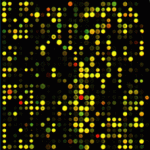Genomics
|
23 january 2015 06:06:22 |
| Transcriptome analysis of food habit transition from carnivory to herbivory in a typical vertebrate herbivore, grass carp Ctenopharyngodon idella (BMC Genomics) |
|
Tweet Background:
Although feeding behavior and food habit are ecologically and economically important properties, little is known about formation and evolution of herbivory. Grass carp (Ctenopharyngodon idella) is an ecologically appealing model of vertebrate herbivore, widely cultivated in the world as edible fish or as biological control agents for aquatic weeds. Grass carp exhibits food habit transition from carnivory to herbivory during development. However, currently little is known about the genes regulating the unique food habit transition and the formation of herbivory, and how they could achieve higher growth rates on plant materials, which have a relatively poor nutritional quality.
Results:
We showed that grass carp fed with duckweed (modeling fish after food habit transition) had significantly higher relative length of gut than fish before food habit transition or those fed with chironomid larvae (fish without transition). Using transcriptome sequencing, we identified 10,184 differentially expressed genes between grass carp before and after transition in brain, liver and gut. By eliminating genes potentially involved in development (via comparing fish with or without food habit transition), we identified changes in expression of genes involved in cell proliferation and differentiation, appetite control, circadian rhythm, and digestion and metabolism between fish before and after food habit transition. Up-regulation of GHRb, Egfr, Fgf, Fgfbp1, Insra, Irs2, Jak, STAT, PKC, PI3K expression in fish fed with duckweed, consistent with faster gut growth, could promote the food habit transition. Grass carp after food habit transition had increased appetite signal in brain. Altered expressions of Per, Cry, Clock, Bmal2, Pdp, Dec and Fbxl3 might reset circadian phase of fish after food habit transition. Expression of genes involved in digestion and metabolism were significantly different between fish before and after the transition.
Conclusions:
We suggest that the food habit transition from carnivory to herbivory in grass carp might be due to enhanced gut growth, increased appetite, resetting of circadian phase and enhanced digestion and metabolism. We also found extensive alternative splicing and novel transcript accompanying food habit transition. These differences together might account for the food habit transition and the formation of herbivory in grass carp. |
| 103 viewsCategory: Genomics |
 Use of targeted SNP selection for an improved anchoring of the melon ( Cucumis melo L.) scaffold genome assembly (BMC Genomics) Use of targeted SNP selection for an improved anchoring of the melon ( Cucumis melo L.) scaffold genome assembly (BMC Genomics)Recent progress in understanding transcription factor binding specificity (Briefings in Functional Genomics and Proteomics) 
|
| blog comments powered by Disqus |
MyJournals.org
The latest issues of all your favorite science journals on one page
The latest issues of all your favorite science journals on one page



